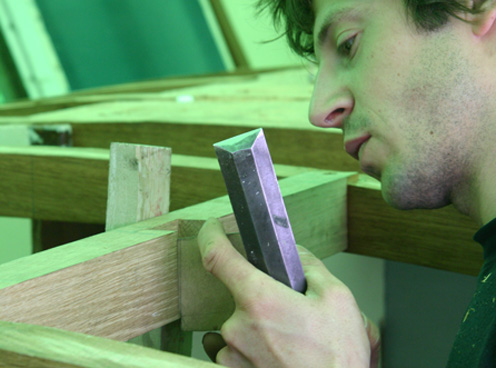ETHICS
A decade working mostly alone, gives you a lot of time to think about issues like sustainability. It seems to be a ‘unique selling point’ for most companies today, a lot of big business seems to think it can buy a clean conscience through carbon offsetting.
I don’t believe there is such a thing as carbon neutral, even when you stop breathing.
That said I do think about the impact of the work I do on the environment all the time. Fundamentally, we don’t exactly need boats in our life so it would be tenuous for me to try and argue the environmental value of my work. On the whole, the people I meet at shows tend to tell me it is great to see these skills preserved, it could also be argued that to repair and re-use are the principles that are lacking in today’s world.


I would say, having considered my working practice over the last ten years, the biggest sustainability issues that concern the marine industry are the choice of materials used, the amount of energy consumed, and how waste is contained and sorted when disposed of. This has led me to avoid working on composite, plywood or heavy displacement boats.
The truth is that the amount of timber that is consumed in the UK’s woodworking industries cannot be supported by the natural world, we have already used the best of these resources. What really worries me is that a lot of this timber may come from ancient woodlands-once these are lost they are lost forever. Basically I believe that timber is very cheap when you consider how long the stuff takes to grow, and it should be used with a sense of this value in mind. Those off-cuts should get mighty small before they are consigned to the wood shed.
All this said, my work uses relatively small quantities of timber. I tend to avoid the use of tropical hardwoods and often fish around in the wood recycling yards for stock. If I get to build a new boat I specify British or European timbers in the hope that they will come from better managed woodland. But I do still buy in Oregon pine for the oars I make and some plank repairs require African mahogany. Somewhat perversely, a lot of the old Thames Skiffs I work on were planked in Brazilian Mahogany which was so durable it tends not to rot, it is mostly the oak components that need to be replaced which I can buy from local sawmills.
Environmental factors do influence the type of work I do; I tend to stick with traditionally constructed boats that are often 50 to 100 plus years old. Traditional methods to my mind are lo-tech, methods and materials are largely unchanged for a few thousand years. I do use power tools and machinery but the work is predominantly done with hand tools and so my energy consumption is low
Traditional work doesn’t need to rely on highly synthesised coatings and bedding compounds and glues that might call for a heated workshop. I do still rely on oil based paint and varnish for my final coats, but otherwise a great deal of what I use is plant based such as turpentine, linseed, pine tar and cotton and linseed putty,
By sticking with traditional solid timber construction, dealing with waste is simplified, it means most of my waste can be sorted into metals for recycling, old timber with paint finishes that go for incineration, sawdust from virgin timber which feeds my compost loo and can be used as bedding for the chooks. I probably produce a bin bag of waste a month that isn’t recyclable.